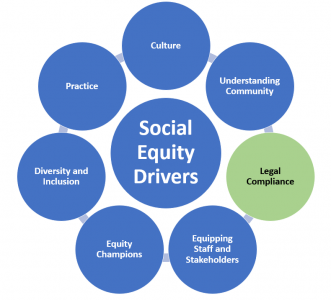Widgetized Section
Go to Admin » Appearance » Widgets » and move Gabfire Widget: Social into that MastheadOverlay zone
Legal Compliance and Social Equity in Emergency Management
The views expressed are those of the author and do not necessarily reflect the views of ASPA as an organization.
By Anthony Buller
March 21, 2022

What makes an emergency management organization more likely to achieve the promises of social equity? Social equity of course “is fundamentally concerned with fairness and justice in the provision of public service.” In this series of columns, I am suggesting that there are drivers of social equity that emergency management should pursue (see the graphic). And specifically, in this column, I am exploring the importance of legal compliance. As I wrote in the introductory column of this series, legal compliance “should be considered a baseline driver for social equity.”
Of course, I’ll start off by saying: I am not an attorney, nor am I giving legal advice. Instead, I am providing perspectives as an emergency management practitioner about how fellow emergency managers can pursue social equity. One of those lines of effort, and a fundamental one at that, must be about the law. There are laws that impact equity inside of an organization (Equal Employment Opportunity (EEO) law, as one example), and there are laws that also impact service to the public—the Americans with Disabilities Act (ADA) does both.
Emergency managers face legal risk before, during and after disaster. Before disaster, we have examples of municipalities being sued for failure to plan for vulnerable populations, and when I say “for” I mean “with” because planning “with” vulnerable populations is often part of the settlements municipalities make with the plaintiffs. During disaster, emergency managers are making decisions that can lead to suit, such as where to send assistance, where and how to operate a shelter and how to evacuate vulnerable persons, etc. During recovery, jurisdictions face scrutiny and also can face suits. The Marshall Fire destroyed more than 1000 homes in Boulder County, Colorado on Dec. 30, 2021. More than three months later and the debris removal contract has been delayed because a competing contractor has sued, alleging contracting process errors.
How does an emergency manager know if their organization is promoting social equity through legal compliance? Here are some good places to start:
#1 – Engage Counsel – It may be incredibly obvious to some, but emergency managers should engage their jurisdiction’s counsel often and especially during disaster. This is the best practice—but of course not all jurisdictions have access to full-time attorneys. If you do, and if you can, then legal counsel should meet with emergency management on a consistent basis to provide input to strategies, help implement some of the below and to advise decision makers when disaster strikes.
#2 – Train Staff – Staff should be trained on relevant laws and other legal landscape information (like relevant settlements) that impact emergency management.
#3 – Empower Staff – Staff and stakeholders should be empowered to “throw the flag” and call attention to noncompliance or any form of risk. This can be incredibly hard for staff to do, but it’s much better to promote flag throwing than it is to defend an illegal decision in court.
#4 – Stay Current with the Legal Landscape – The legal landscape is always changing. As said above, the law isn’t the only thing emergency managers have to pay attention to. Regulations and court actions, including those from other jurisdictions, can have a major impact.
#5 – Document Decisions – Many emergency management departments have systems for documenting decisions during events. Resource tracking is just part of it. Setting objectives, determining types of assistance and how and where to deliver that aid, is important too. Emergency managers should also document decisions during the planning phase and in all cases be ready to explain, perhaps under oath, what led to those decisions.
#6 – Develop and Follow Plans – Emergency managers would benefit from strategizing with legal counsel on how to best comply with legal requirements and avoid risk. A simple plan about when to engage the counsel would be a good place to start. Then, addressing how the counsel will support on disaster will also help. But the key is that with such a strategy (and any plan really) others might someday ask: why did you deviate from your plan? So, follow the strategy or have a good, well-documented reason for not doing so.
These six approaches can be used to assess and improve your emergency management organization. The next column in this series will explore the equipping staff and stakeholders driver. Equipping others is a universal effort emergency managers engage in at all levels of government. Doing it well, and making sure you are inclusive, is a key driver of social equity.
Author: Anthony Buller has deployed to more than 40 presidentially declared major disasters and emergencies in his 17 years of federal service. He leads a team of emergency management professionals covering the western US for a federal agency. He can be reached at: [email protected].


Follow Us!